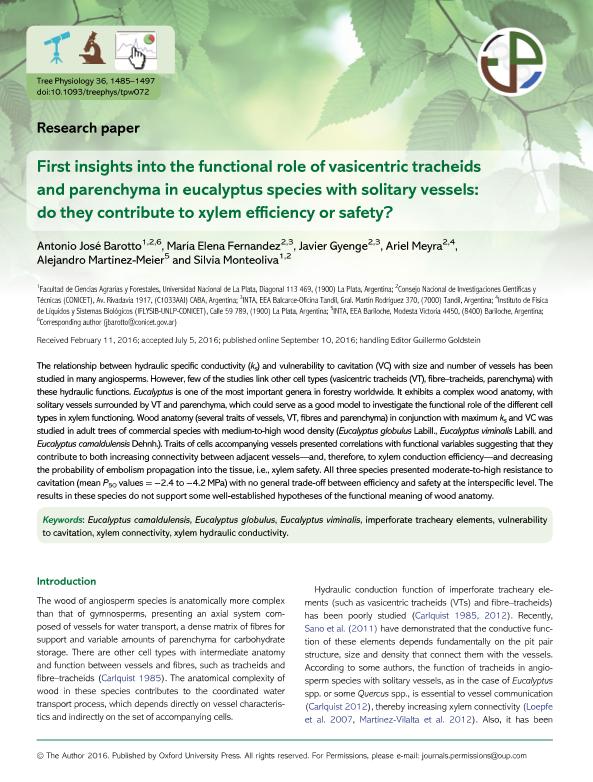Mostrar el registro sencillo del ítem
dc.contributor.author
Barotto, Antonio José

dc.contributor.author
Fernandez, Maria Elena

dc.contributor.author
Gyenge, Javier Enrique

dc.contributor.author
Meyra, Ariel German

dc.contributor.author
Martinez Meier, Alejandro
dc.contributor.author
Monteoliva, Silvia Estela

dc.date.available
2019-12-13T18:28:27Z
dc.date.issued
2016-07
dc.identifier.citation
Barotto, Antonio José; Fernandez, Maria Elena; Gyenge, Javier Enrique; Meyra, Ariel German; Martinez Meier, Alejandro; et al.; First insights into the functional role of vasicentric tracheids and parenchyma in eucalyptus species with solitary vessels: Do they contribute to xylem efficiency or safety?; Oxford University Press; Tree Physiology; 36; 12; 7-2016; 1485-1497
dc.identifier.issn
0829-318X
dc.identifier.uri
http://hdl.handle.net/11336/92192
dc.description.abstract
The relationship between hydraulic specific conductivity (ks) and vulnerability to cavitation (VC) with size and number of vessels has been studied in many angiosperms. However, few of the studies link other cell types (vasicentric tracheids (VT), fibre–tracheids, parenchyma) with these hydraulic functions. Eucalyptus is one of the most important genera in forestry worldwide. It exhibits a complex wood anatomy, with solitary vessels surrounded by VT and parenchyma, which could serve as a good model to investigate the functional role of the different cell types in xylem functioning. Wood anatomy (several traits of vessels, VT, fibres and parenchyma) in conjunction with maximum ks and VC was studied in adult trees of commercial species with medium-to-high wood density (Eucalyptus globulus Labill., Eucalyptus viminalis Labill. and Eucalyptus camaldulensis Dehnh.). Traits of cells accompanying vessels presented correlations with functional variables suggesting that they contribute to both increasing connectivity between adjacent vessels—and, therefore, to xylem conduction efficiency—and decreasing the probability of embolism propagation into the tissue, i.e., xylem safety. All three species presented moderate-to-high resistance to cavitation (mean P50 values = −2.4 to −4.2 MPa) with no general trade-off between efficiency and safety at the interspecific level. The results in these species do not support some well-established hypotheses of the functional meaning of wood anatomy.
dc.format
application/pdf
dc.language.iso
eng
dc.publisher
Oxford University Press

dc.rights
info:eu-repo/semantics/openAccess
dc.rights.uri
https://creativecommons.org/licenses/by-nc-sa/2.5/ar/
dc.subject
EUCALYPTUS CAMALDULENSIS
dc.subject
EUCALYPTUS GLOBULUS
dc.subject
EUCALYPTUS VIMINALIS
dc.subject
IMPERFORATE TRACHEARY ELEMENTS
dc.subject
VULNERABILITY TO CAVITATION
dc.subject
XYLEM CONNECTIVITY
dc.subject
XYLEM HYDRAULIC CONDUCTIVITY
dc.subject.classification
Otras Agricultura, Silvicultura y Pesca

dc.subject.classification
Agricultura, Silvicultura y Pesca

dc.subject.classification
CIENCIAS AGRÍCOLAS

dc.title
First insights into the functional role of vasicentric tracheids and parenchyma in eucalyptus species with solitary vessels: Do they contribute to xylem efficiency or safety?
dc.type
info:eu-repo/semantics/article
dc.type
info:ar-repo/semantics/artículo
dc.type
info:eu-repo/semantics/publishedVersion
dc.date.updated
2019-12-05T18:08:10Z
dc.journal.volume
36
dc.journal.number
12
dc.journal.pagination
1485-1497
dc.journal.pais
Reino Unido

dc.journal.ciudad
Oxford
dc.description.fil
Fil: Barotto, Antonio José. Consejo Nacional de Investigaciones Científicas y Técnicas; Argentina. Universidad Nacional de La Plata. Facultad de Ciencias Agrarias y Forestales; Argentina
dc.description.fil
Fil: Fernandez, Maria Elena. Consejo Nacional de Investigaciones Científicas y Técnicas; Argentina. Instituto Nacional de Tecnología Agropecuaria. Centro Regional Buenos Aires Sur. Estación Experimental Agropecuaria Balcarce; Argentina
dc.description.fil
Fil: Gyenge, Javier Enrique. Consejo Nacional de Investigaciones Científicas y Técnicas; Argentina. Instituto Nacional de Tecnología Agropecuaria. Centro Regional Buenos Aires Sur. Estación Experimental Agropecuaria Balcarce; Argentina
dc.description.fil
Fil: Meyra, Ariel German. Consejo Nacional de Investigaciones Científicas y Técnicas. Centro Científico Tecnológico Conicet - La Plata. Instituto de Física de Líquidos y Sistemas Biológicos. Universidad Nacional de La Plata. Facultad de Ciencias Exactas. Instituto de Física de Líquidos y Sistemas Biológicos; Argentina
dc.description.fil
Fil: Martinez Meier, Alejandro. Instituto Nacional de Tecnología Agropecuaria. Centro Regional Patagonia Norte. Estación Experimental Agropecuaria San Carlos de Bariloche; Argentina
dc.description.fil
Fil: Monteoliva, Silvia Estela. Consejo Nacional de Investigaciones Científicas y Técnicas; Argentina. Universidad Nacional de La Plata. Facultad de Ciencias Agrarias y Forestales; Argentina
dc.journal.title
Tree Physiology

dc.relation.alternativeid
info:eu-repo/semantics/altIdentifier/url/https://academic.oup.com/treephys/article-abstract/36/12/1485/2527784/First-insights-into-the-functional-role-of
dc.relation.alternativeid
info:eu-repo/semantics/altIdentifier/doi/http://dx.doi.org/10.1093/treephys/tpw072
Archivos asociados
